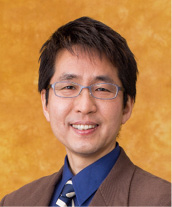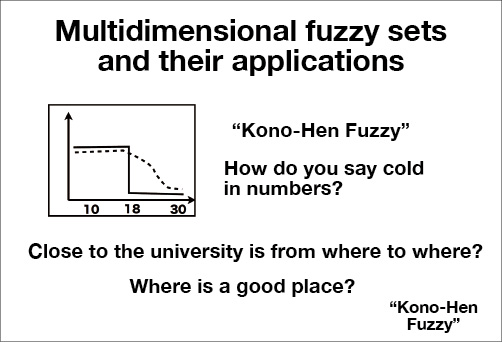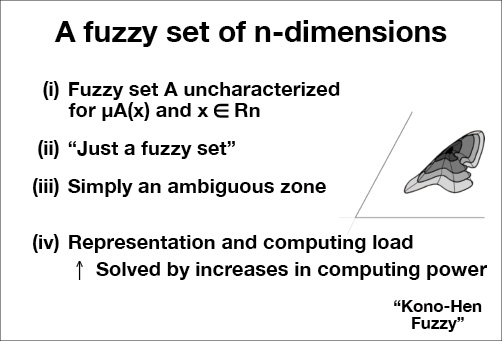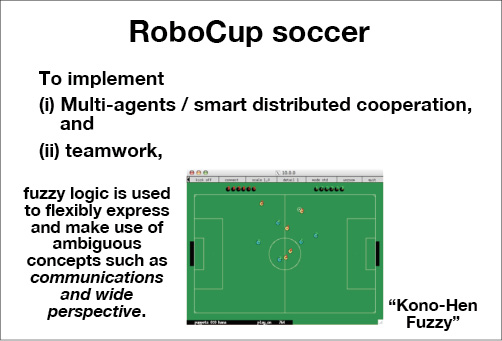
As of August, 2015
| Faculty/Department | Department of Communication Engineering and Informatics Graduate School of Informatics and Engineering |

|
| Members | Junji Nishino, Assistant professor | |
| Affiliations | Japan Society for Fuzzy Theory and Intelligent Informatics, Information Processing Society of Japan | |
| Website | https://sites.google.com/view/konohenfuzzy/ | |
Fuzzy, Fuzzy logic, Fuzzy controls, Fuzzy sets, RoboCup, Soccer, Daihinmin (The Poorest of the Poor), Playing cards, R language, Control theory, Modern control theory, Optimized control theory
One principle at the heart of scientific technique is the pursuit of exactness. This principle decrees that ambiguity should be ironed out wherever possible, and results should be expressed and controlled with ever-greater accuracy. The ideal expression is the numerical formula. Numerical formulas do not harbor ambiguity. It is extremely commonplace to use numerical formulas to define systems that are based on electrical engineering or mechanical engineering.
The logic circuits on which our computer systems are built recognize only two states: true and false. This binary logic of logic circuits pushes ambiguity to almost zero.
And yet, human society is not always highly accurate or precise. Indeed, far from being precise, our world is more ordinarily found to be somewhat abstract or ambiguous.
For example, think of the expression hot. Temperature is undoubtedly a major factor in determining hotness. We could, for argument’s sake, define hot (i.e., the true logical value) as any temperature 25 degrees Celsius or above. Conversely, any temperature below 25 degrees Celsius would be defined as not hot (i.e., the false logical value). But the impossibility of using 25 degrees Celsius as a boundary value in reality soon becomes apparent. The temperature at which people sense hotness varies by season and by region. And different people have different sensitivities to temperature.
Creating an all-encompassing definition of hot that accounts for every one of these variances has necessitated a massive number of conditions and a huge number of boundaries (temperature settings). The pursuit of exactness leads to more and more definitions, each more complex than before. More definitions and complexity causes the systems used to find greater precision to become extremely complicated, which means the system designs become more difficult and much more expensive.
Even more troubling is the escalating fear that the design simulations the systems generate will turn out to be unrealistic. Simulations make assumptions for a great number of parameters, but if there are too many parameters in play, the error contained in each can accumulate to the point where results are simply untenable or fantastical.
And then people began turning old concepts on their head. Instead of pursuing exactness, the idea went, why not develop systems that assume ambiguity? Since ambiguity is quite fuzzy, the logic based on this thinking became known as fuzzy logic.
Fuzzy logic drew considerable attention - to a degree where it could be rightly called a fad - for a time in the 1980s and 1990s, as a means of expanding the possibilities of previous mathematical theory and control theory. Fuzzy controls, an application of the ideas of fuzzy logic to control theory, were put to work in the control of subway cars, elevators, and even household appliances.
It was during this time that Assistant Professor Junji Nishino first encountered fuzzy controls. In graduate school, he was involved in a research project that applied fuzzy controls to the automated control of an unmanned helicopter. The project was the first in the world to successfully automate the hovering of an unmanned helicopter. This was about 25 years ago. Assistant Professor Nishino has been researching fuzzy logic ever since.
The world has changed a great deal in 25 years. Fuzzy controls were once the subject of a lot of attention for a time, but in recent years, the buzz has definitely faded. With the tremendous increase in computers’ computational power per unit cost and the advances of mathematical modeling, it is now entirely possible to design very elaborate and complex systems at realistic costs without relying on fuzzy logic or controls.
Despite fuzzy logic’s decline, Assistant Professor Nishino believes there are still many areas where fuzzy logic can flourish. One of these areas is multidimensional fuzzy logic (see Figure 1), which is a research theme for the Nishino laboratory.

During their boom years in the 1980s and 1990s, fuzzy controls dealt with one-dimensional quantities: for example, controlling speed, or temperature, or distance. They dealt with only one physical quantity at a time. Multidimensional fuzzy controls, on the other hand, deal with multiple physical quantities.
Think, for example, of an HVAC system that simultaneously controls two physical quantities: temperature and humidity. The system’s target comfort zone is defined on an x-y graph, where the x axis is temperature and the y axis is humidity.
To accomplish this with a one-dimensional fuzzy control, a temperature fuzzy set and a humidity fuzzy set would have to be created and a two-dimensional comfort zone defined from the product and sum of the two sets. Very large fuzzy sets would have to be created with this method if the curve enclosing the comfort zone had a complex shape. This in turn would cause the computation volume to skyrocket and the system to become overly complex. The converse problem is that the use of smaller fuzzy sets would incur larger errors.
With a multidimensional fuzzy control, a fuzzy set with two or more dimensions is created (see Figure 2). Fuzzy sets are expressed by a large number of sample points. The big advantage is, although collecting many sample points is necessary and calculations are needed to supplement the sample points, once the fuzzy set is created, the controls themselves become extremely simple.

Assistant Professor Nishino calls these multidimensional fuzzy controls “Kono-Hen Fuzzy” and is seeking to popularize the name as a trademark.
A leading example of the results from “Kono-Hen Fuzzy” research that Assistant Professor Nishino advocates is computer simulation technology for robot players entered in the RoboCup, a soccer tournament played by robots. RoboCup is a global research project whose official goal is: “By the middle of the 21st century, a team of fully autonomous humanoid robot soccer players shall win a soccer game, complying with the official rules of FIFA, against the winner of the most recent World Cup.” A global RoboCup tournament is held every year.
In addition to leagues where purpose-built robots compete, there are also simulation leagues in which virtual robots play soccer in a computer simulation. Assistant Professor Nishino is researching simulation software for these computer simulation leagues. One example is the use of “Kono-Hen Fuzzy” in evaluating game situations (see Figure 3).

Another fruitful research area is computer simulations of the multi-player (three or more) Japanese card game called Daihinmin (which, roughly, means “the poorest of the poor.” It is similar to the Western card game President). In this multi-player game, situations occur where, mathematically, you cannot finish either at the top or at the bottom, but your move will determine who does finish at the top. When the tables are turned, the move by another player (who is not at the bottom or the top) will determine whether you can finish at the top. Dealing with these ambiguous dilemmas with rigorous logic is very difficult, but fuzzy logic is well suited for these situations.
The Daihinmin research has yielded some very interesting results. Most of us would think that knowing the other players’ hands would be an advantage in the game. The research’s conclusion, however, showed that whether or not one knew the other players’ hands had little relationship on the outcome of the game. Putting it another way, there is an optimal order for getting rid of all your cards in the fewest turns. Thus, the outcome of the game is largely determined when the cards are first dealt regardless of the other player’s moves.
Assistant Professor Nishino is aiming to revive fuzzy logic with his “Kono-Hen Fuzzy”. He even refers to himself as a fuzzy evangelist. The day when fuzzy logic is back in the limelight does not seem that far away.
[Interview and article by Akira Fukuda (PR Center)]